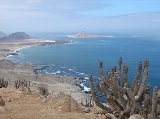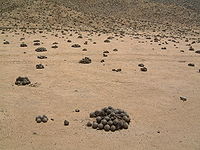
Pan de Azúcar National Park
Encyclopedia
Pan de Azúcar National Park is a national park of Chile
. The park straddles the border between the Antofagasta Region
and the Atacama Region
. Its name, Parque Nacional Pan de Azúcar, means "sugar loaf".
 The park is located 30 km north of Chañaral and 180 km north of Copiapó. It was founded in 1985 and has an extension of 437.54 km² (including 1.1 km² of insular terrain). It is importance derives from the relative diversity of species.
The park is located 30 km north of Chañaral and 180 km north of Copiapó. It was founded in 1985 and has an extension of 437.54 km² (including 1.1 km² of insular terrain). It is importance derives from the relative diversity of species.
The park can be reached most conveniently from Chañaral.
A small gravel road leads along the ocean to the park, passing Playa Amarilla (yellow beach) and Playa Blanca (white beach) on the way. Many cactus species can be observed along the road. Some people make the tour by bicycle and spend the night at Caleta Pan de Azúcar or camp on the mountains (the night can get uncomfortably cold because of the mist).
 Isla Pan de Azúcar is located 24 km farther. Humboldt Penguin
Isla Pan de Azúcar is located 24 km farther. Humboldt Penguin
s breed on this island. The island can be reached by boat from the mainland but passengers are not allowed to leave the boat.
 From the cove northward there is a gravel road which connects to the Pan-American Highway
From the cove northward there is a gravel road which connects to the Pan-American Highway
. Along the way there are numerous interesting geological formations.
 Pan de Azúcar NP is divided into two ecosystems: the coastal desert of Taltal and the steppe desert of the Sierra Vicuña Mackenna. The absence of rain is compensated by coastal mist, which is known locally as Camanchaca.
Pan de Azúcar NP is divided into two ecosystems: the coastal desert of Taltal and the steppe desert of the Sierra Vicuña Mackenna. The absence of rain is compensated by coastal mist, which is known locally as Camanchaca.
There are more than 20 cactus species in the area, mainly of the genus Copiapoa
which can be also be observed in the Cactarium located in the Environmental office of CONAF in front of Los Piqueros Beach 4,96 miles from the park entrance. It is open for visits from Monday to Sunday from 8:30 to 12:30 and from 14 to 18 hours.
The Guanaco is the main mammal found in the park. Other mammals include Culpeo Fox
, Chilla Fox and European Hare
. The shoreline area is home to marine mammal
s, such as the Marine Otter
and the South American Sea Lion
. Among the birds are the Humboldt Penguin and Peruvian Pelican
. Also reptile species of the genera Tropidurus
and Callopistes
inhabit the park.
Chile
Chile ,officially the Republic of Chile , is a country in South America occupying a long, narrow coastal strip between the Andes mountains to the east and the Pacific Ocean to the west. It borders Peru to the north, Bolivia to the northeast, Argentina to the east, and the Drake Passage in the far...
. The park straddles the border between the Antofagasta Region
Antofagasta Region
The II Antofagasta Region is one of Chile's fifteen first-order administrative divisions. It comprises three provinces, Antofagasta, El Loa and Tocopilla...
and the Atacama Region
Atacama Region
The Atacama Region is one of Chile's 15 first order administrative divisions. It comprises three provinces, Chañaral, Copiapó and Huasco. It is bordered to the north by Antofagasta, to the south by Coquimbo, to east with Provinces of Catamarca, La Rioja and San Juan of Argentina, and to west with...
. Its name, Parque Nacional Pan de Azúcar, means "sugar loaf".
Geography

The park can be reached most conveniently from Chañaral.
- Take C-120 route that goes from Chañaral to Park's Management office (17.9 miles).
- Route 5 - Panamerican Highway at km 1014, at Las Bombas, you can reach it through a secondary road.
A small gravel road leads along the ocean to the park, passing Playa Amarilla (yellow beach) and Playa Blanca (white beach) on the way. Many cactus species can be observed along the road. Some people make the tour by bicycle and spend the night at Caleta Pan de Azúcar or camp on the mountains (the night can get uncomfortably cold because of the mist).
Isla Pan de Azúcar

Humboldt Penguin
The Humboldt Penguin is a South American penguin, that breeds in coastal Peru and Chile. Its nearest relatives are the African Penguin, the Magellanic Penguin and the Galápagos Penguin...
s breed on this island. The island can be reached by boat from the mainland but passengers are not allowed to leave the boat.
Caleta Pan de Azúcar
Caleta Pan de Azúcar (Pan de Azúcar Cove) is a small fisher settlement who cater now to the local tourism. Formerly copper was worked here and freighted by boat. Divers can still explore parts of the wharf, the loading crane and other things below the water. From here the look-out point of Mirador 8 km farther can be reached. On the mountain slopes nearby an extraordinary fauna can be observed which stays alive thanks to the coastal mist.North of Caleta Pan de Azúcar

Pan-American Highway
The Pan-American Highway is a network of roads measuring about in total length. Except for an rainforest break, called the Darién Gap, the road links the mainland nations of the Americas in a connected highway system. According to Guinness World Records, the Pan-American Highway is the world's...
. Along the way there are numerous interesting geological formations.
Biology

There are more than 20 cactus species in the area, mainly of the genus Copiapoa
Copiapoa
Copiapoa is a genus of cacti from the dry coastal deserts of northern Chile. It comprises about 26 species. These species vary in form from spherical to slightly columnar and in color from a brownish to blue-green body.-Taxonomy:...
which can be also be observed in the Cactarium located in the Environmental office of CONAF in front of Los Piqueros Beach 4,96 miles from the park entrance. It is open for visits from Monday to Sunday from 8:30 to 12:30 and from 14 to 18 hours.
The Guanaco is the main mammal found in the park. Other mammals include Culpeo Fox
Culpeo
The culpeo , sometimes known as the culpeo zorro or Andean fox , is a South American species of wild dog. It is the second largest native canid on the continent after the maned wolf. In its appearance it bears many similarities to the widely recognized red fox...
, Chilla Fox and European Hare
European Hare
The European hare , also known as the brown hare, Eastern Jackrabbit and Eastern prairie hare, is a species of hare native to northern, central, and western Europe and western Asia. It is a mammal adapted to temperate open country. It is related to the similarly appearing rabbit, which is in the...
. The shoreline area is home to marine mammal
Marine mammal
Marine mammals, which include seals, whales, dolphins, and walruses, form a diverse group of 128 species that rely on the ocean for their existence. They do not represent a distinct biological grouping, but rather are unified by their reliance on the marine environment for feeding. The level of...
s, such as the Marine Otter
Marine Otter
The marine otter, Lontra felina, is a rare and poorly-known South American mammal of the weasel family . The scientific name means "otter cat", and in Spanish the marine otter is also often referred to as : "marine cat"...
and the South American Sea Lion
South American Sea Lion
The South American sea lion , also called the southern sea lion and the Patagonian sea lion, is a sea lion found on the Chilean, Peruvian, Uruguayan, Argentine and Southern Brazilian coasts. It is the only member of the genus Otaria...
. Among the birds are the Humboldt Penguin and Peruvian Pelican
Peruvian Pelican
The Peruvian Pelican, Pelecanus thagus, is a member of the pelican family. It lives on the west coast of South America, from Lobos de Tierra Island in Peru to Pupuya Islet in Chile....
. Also reptile species of the genera Tropidurus
Tropidurus
The reptile genus Tropidurus includes several species of Neotropical ground lizards . It is the type genus of this family of iguanian lizards. They are found on the South American mainland, especially in the Amazon Rainforest but also in more arid regions...
and Callopistes
Callopistes
Callopistes is a lizard genus which belongs to the family of Teiidae. They are native to Ecuador, Peru and Chile.-Classification:Genus Callopistes*Callopistes flavipunctatus*Callopistes maculatus...
inhabit the park.

